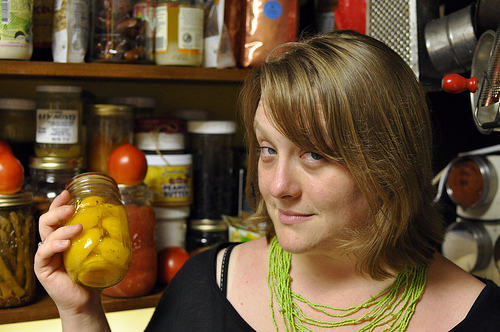BAB caught up with McClellan at the recent BlogHer Food conference in Seattle. As a former Portlandian, it must be noted that this canner was dispensing cookbook postcards via a thoroughly au courant little purse with, yes, dear readers, birds on it. Proving, perhaps, that you can take the pickler out of Portland, but you can't take Portlandia out of this preserver.
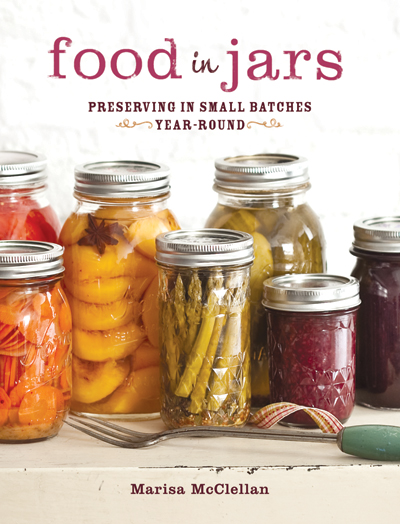
How is your book different from all the other canning, jamming, and pickling cookbooks already out there?
It's a modern take on small batch canning -- between three and four pints. Most classic canning recipes are designed to fill a canning pot, we're talking seven to nine pints. Living in a small apartment I found that was always far too much: My apartment is a little less than 1,100 square feet and my kitchen is about 80 square feet, so storage and counter space are at a premium. For me, small batches are a way to be creative and explore different flavor combinations without canning taking up my whole life.
How would you characterize the canning community here?
The West Coast canning scene is about three or four years ahead of the East Coast -- that's just how things tend to happen in food trends -- the East Coast is a little slower to pick up on things. The West Coast has ridiculously beautiful produce. California, Oregon, and Washington are all blessed, and people should remember not to take it for granted.
What do you miss about West Coast eating and drinking?
Pennsylvania has a lot of obnoxious liquor laws. I miss being able to buy a bottle of wine in the grocery store.
I miss the general aesthetic and attitude of the West Coast around food -- especially California -- everybody is really engaged in food here, whether it's preserving or wanting to make things from scratch. On the East Coast I often feel like I'm shouting to an empty room.
What's wonderful on the food front where you live?
We get really great sour cherries. And sour cherry jam is one of my favorite jams to make. So I feel really lucky to live in a place that has such an abundant sour cherry season.
We're also fortunate to have the classic Brandywine tomato, which is originally from Pennsylvania. It was developed for that soil and it grows beautifully in that area. It's particularly good for sauces and salsas.
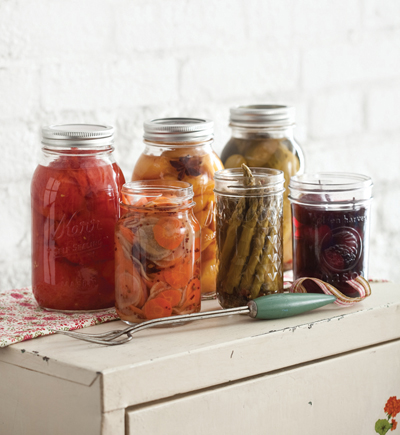
Savory and sweet preserved produce. Photo: Steve Legato
How do you explain the new-found popularity of putting up?
So many factors have come together right now to make preserving popular again. There's the locavore movement: If you want to eat locally and have variety through the winter and live in a colder place, as I do, then you've got to can. There's the fact that people want some control over their food -- they want to avoid chemicals or BPA -- and the best way to know what's in your food is by canning it yourself. There are also economic factors: People need to save money and canning can be one way to do that.
And there's also the fact that many people are really disconnected from their food and they want to be more in touch with it and canning is a way to do that too. All those factors are coming together and making it just a perfect storm for food preservation.
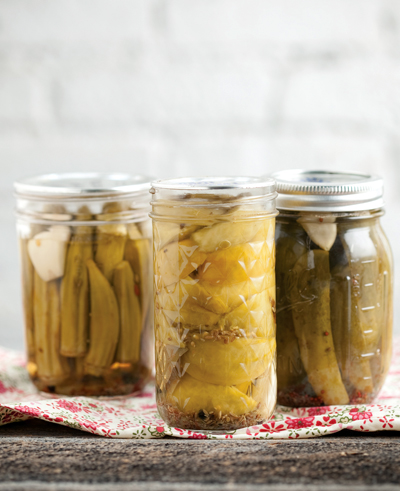
Pickle pleasure. Photo: Steve Legato
What's a good gateway savory and sweet option for novice preservers?
On the vegetable side: basic refrigerator pickle, you don't even have to do the boiling water bath process. It's just chopping cucumbers, adding some garlic and other spices, pouring some hot vinegar over it, and letting it sit in the refrigerator for a day or two. That makes the best, crunchiest, most flavorful pickle you've ever had. They'll stay crisp and good in the refrigerator for three or four weeks as opposed to six to twelve months on the shelf but the texture is better if you just do it as a refrigerator pickle.
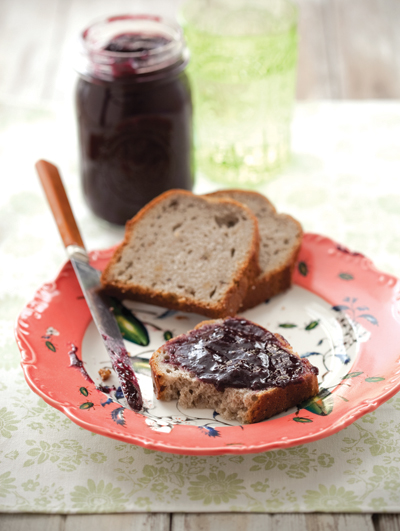
Blueberry butter. Photo: Steve Legato
On the fruit side: blueberry jam because blueberries are very high in natural pectin, so even a beginner is going to get a good jammy set out of blueberries. Strawberries -- which new jammers often try first -- are one of the hardest to get a good set out of, so they end up with a failure, a strawberry syrup, and they're disappointed and may not make jam again because it didn't turn out. Blueberry jam always turns out.
How do you feel about the cult status and gentle mockery of preserving by the Portlandia crew: "We Can Pickle That!"
At first I was sort of uneasy about the whole Portlandia thing and now I love it. I feel like: Why not? The more people talk about this stuff the better. It's making fun of it but it's doing it in a loving way and that's fine with me. I laugh when I watch Portlandia because I feel like I know those people, I grew up with those people.
Details:
Wednesday, June 20
4-5 pm - Book signing at HMSBeekeeper, 3520 20th Street, San Francisco, Free.
7-9 pm - Class at Cookhouse, 253 Columbus Avenue, San Francisco. $65.
Registration here.
Thursday, June 21
12-2 pm - Class at Purcell Murray, 185 Park Lane, Brisbane. $35
Registration here.
6-7 pm - Book signing and refrigerator pickle workshop at Omnivore Books, 3885a Cesar Chavez Street, San Francisco, $10
Friday, June 22
7-9 pm - Canning class at Ripe author Cheryl Sternman Rule's San Jose home. (Sold out.)

Photo: Marisa McClellan
Recipe: Apricot Jam
Apricot was not part of my childhood repertoire of jams. When it came to homemade jams, we were more of a plum and blueberry crowd. So I never gave it much thought until the day someone introduced me to the company “We Love Jam” and their Blenheim apricot jam, and it blew my preserve-lovin’ mind.
While I can’t get those precious Blenheims where I live, I’ve found that just about any locally grown, tree-ripened apricot makes stellar jam and I can’t really see going a year without its sweet-tart goodness for spreading on buttered toast.
Makes: 3 (1 pint/500 ml) jars
Ingredients:
6 cups peeled, pitted, and diced apricots (about 3 pounds/1.4 kg whole apricots)
31/2 cups/700 g granulated sugar
Zest and juice of 1 lemon
Instructions:
Prepare a boiling water bath and 3 regular-mouth 1-pint/500 ml jars according to the process on page 11.
Place the lids in a small saucepan, cover them with water, and simmer over very low heat.
Combine the apricots and sugar in a large pot and bring to a boil over medium-high heat. Boil for 10 to 15 minutes, until the fruit is tender and the liquid looks syrupy.
Add the lemon juice and zest and return to a boil. Insert your candy thermometer into the jam and attach it to the side of the pot. Let the jam boil vigorously until it reaches 220°F/105°C.
When the jam has reached 220°F/105°C and the temperature has remained steady for 2 minutes, remove the pot from the heat and ladle the jam into the prepared jars. Wipe the rims, apply the lids and rings, and process in a boiling water bath for 10 minutes.
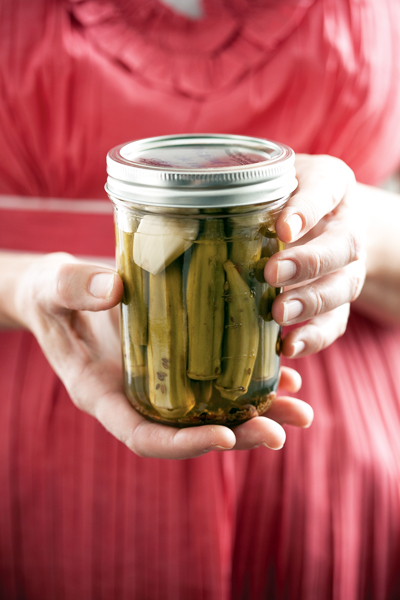
Photo: Steve Legato
Recipe: Pickled Okra
During my early canning days, I spent a week in Austin, Texas. It was there that I had the chance to try the most delectable fried okra I’d ever encountered. It transformed my opinion of this sometimes texturally challenging vegetable and sent me running to the kitchen to try it as a pickle.
It was transcendently good. Pickling manages to eradicate the interior slime and just leaves you with a crunchy, brine-filled pickle. It’s a dream eaten alongside a plate of spicy food.
Makes: 4 (1-pint/500 ml) jars
Ingredients:
3 cups/720 ml apple cider vinegar
3 tablespoons pickling salt
4 lemon slices
4 tablespoons Mixed Pickling Spice (see recipe below), divided
2 pounds/910 g okra, washed and trimmed
4 garlic cloves, peeled
Instructions:
Prepare a boiling water bath and 4 regular-mouth 1-pint/500 ml jars according to the process on page 11. Place the lids in a small saucepan, cover them with water, and simmer over very low heat.
Combine the vinegar, 3 cups/720 ml water, and pickling salt in a pot and bring the brine to a boil.
Meanwhile, put a lemon slice and 1 tablespoon pickling spice in the bottom of each sterilized jar. Then pack the okra in, first laying them in so that the points are up. Then insert another layer with the points down, so that they interlock. Nestle 1 garlic clove among the okra in each jar.
Slowly pour the hot brine over the okra in each jar, leaving 1/2 inch/12 mm headspace. Gently tap the jars on a towel-lined countertop to help loosen any bubbles before using a wooden chopstick to dislodge any remaining bubbles. Check the headspace again and add more brine if necessary.
Wipe the rims, apply the lids and rings, and process in a hot water bath for 10 minutes.
Recipe: Mixed Pickling Spice
You can buy ready-made pickling spice from a variety of outlets and manufacturers and many of them are excellent. I like to mix my own so that I can customize the balance of flavors. As you spend some time making and eating your pickles, you can adjust the amounts to please your palate. The proportions I particularly like are listed below. However, if making your own pickling spice feels like a daunting task, feel free to use a pre-blended mix. I like the one that Penzeys Spices makes.
Ingredients:
3 tablespoons each:
Crushed bay leaves
Peppercorns
Whole allspice
Coriander seeds
Mustard seeds
Juniper berries
1 tablespoon each:
Whole cloves
Broken cinnamon stick
Dill seed
Instructions:
Pour all the spices into a jar and shake to combine. Use any time a mixed pickling spice is called for.
